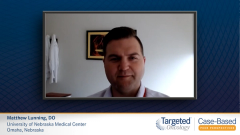
The L-MIND Trial in R/R DLBCL
Matthew Lunning, DO, presents the efficacy and safety findings of the L-MIND trial in relapsed/refractory diffuse large B-cell lymphoma and discusses the implications for clinical practice.
Matthew Lunning, DO: In this case the patient did elect to go on to tafasitamab, lenalidomide. Looking at the L-MIND data, tafasitamab is a CD19 monoclonal antibody that has been studied as a monotherapy, but has also been studied and found to be synergistic with lenalidomide, at least in vitro models. This was tested in the L-MIND setting for patients with relapsed/refractory diffuse large B-cell lymphoma. What I found interesting about the L-MIND data is that individually, lenalidomide in relapsed/refractory large B-cell lymphoma and tafasitamab did not appear to have individually high overall response [OR] rates or high CR [complete response] rates. But when you add them together, those overall response rates and CR rates went up significantly above what each individual drug would’ve brought to the table. The other thing was you were seeing response rates that had the ability to be durable. That’s been the most impressive part of the tafasitamab, lenalidomide data, that you can get patients with relapsed/refractory diffuse large B-cell lymphoma into a remission, and then those remissions could be durable. Often in relapsed/refractory diffuse large B-cell lymphoma, patients do achieve an early response, but that response has difficulty being durable, and that’s often reflected in the progression-free survival curves.
What does this mean for the patient? Well, the way that the lenalidomide, tafasitamab regimen is structured, with tafasitamab given I believe 13 doses in the first 3 months, as well as lenalidomide dosed at 25 mg on a 21-out-of-28-day basis, can give a lot of therapy that you need to get the disease under control early on. With this dosing strategy, I believe it does afford patients to have the opportunity for remission, and then the lenalidomide and tafasitamab is continued. The lenalidomide’s continued for up to a year, and the tafasitamab is continued indefinitely every other month after the third cycle.
With that, one of the other parts of the L-MIND data that intrigued me was the ability to maintain dose intensity. I believe over 8 out of 10 of the patients on the study were able to continue on 20 mg or greater of lenalidomide. I’ve found it can be difficult to get 25 mg or even 20 mg of lenalidomide into patients with relapsed/refractory diffuse large B-cell lymphoma. Perhaps this is because I’ve often, prior to this regimen, used it in later lines of therapy, where the patients have seen much more chemotherapy then if you were giving it in, for instance, the second-line therapy.
Also thinking about the long-term outcomes from the L-MIND study, what’s been impressive is that the duration of remission appears to continue to hold, at least in the clinical trials. As it gets out into the commercial environment, it’ll be interesting to see in the post-marketing phase whether that long-term duration of remission can be achieved outside of a clinical trial. The toxicity profile…I think is interesting because lenalidomide toxicities in my mind are potentially rash early on, tumor flares, but also [blood cell] count suppressions. And so being able to manage neutropenia, anemia, thrombocytopenia with dose reductions as well as with growth factor support. There can be the risk of infusional reaction with tafasitamab, and obviously infections with both drugs in combination. But it appears that those infusional reactions can be managed with supported medications.
Then people start talking about maintenance therapies. What’s interesting in this regimen is the lenalidomide was continued for 12 cycles and then dropped, and the tafasitamab continued. Whether you call this continuation of therapy or maintenance therapy just because you drop one of the drugs, and likely those people are obtaining a clinical benefit whether they’re a CR or a PR [partial response]. I think you must realize that if you’re using this in a relapsed/refractory large cell lymphoma setting, it’s very unique for a patient to still be in a remission at 12 months…especially when you’re not giving intensive chemotherapy and consolidating with an autologous stem cell transplant. In my mind, if the patient’s tolerating tafasitamab at the end of the 12th cycle, I would likely continue maintenance therapy every 2 weeks. We don't have a lot of data to my knowledge of lengthening the tafasitamab dosing regimen to let’s say every 4 weeks or every 6 weeks. And so short of that data, in this situation where a patient is doing well from a response standpoint, unless there are toxicity issues, I’d likely discuss with them continuing it every 2 weeks.
Transcript edited for clarity.
Case: A 71-Year-Old Woman with R/R DLBCL
Initial presentation
- A 71-year-old woman presented with fatigue, weight loss and pruritus
- PMH: HTN, medically controlled
- PE: palpable axillary and femoral lymphadenopathy; palpable spleen 3 cm below the midclavicular line
- ECOG PS 1
Clinical Workup
- Labs: Hb 9.8 g/dL, LDH 2x ULN; renal and hepatic function WNL
- Hepatitis B, C and HIV negative
- Excisional biopsy of a right enlarged axillary lymph node confirmed DLBCL, GCB subtype
- IHC positive for: CD10, CD20
- FISH panel: t(14;18) translocation with BCL2 rearrangement, no MYC or BCL2 rearrangements
- Flow cytometry: CD19-postitive
- Whole body PET/CT scan showed FDG avidity in the bilateral axillary and femoral regions, largest lymph node 3.6 cm in right axillary space; splenomegaly
- Bone marrow biopsy showed involvement of DLBCL in the bone marrow
- Ann Arbor stage IVa DLBCL, GCB subtype
- IPI score high-risk
Treatment
- Treated with R-CHOP x 6 cycles
- First post-treatment PET/CT scan unremarkable; metabolic CR based on Deauville criteria
- 9 months later there was relapse of disease with new cervical and mediastinal lymphadenopathy
- Core needle biopsy of a cervical lymph node confirms a relapse of DLBCL, GCB subtype
- She was offered ASCT but deferred
- Initiated tafasitamab + lenalidomide










































